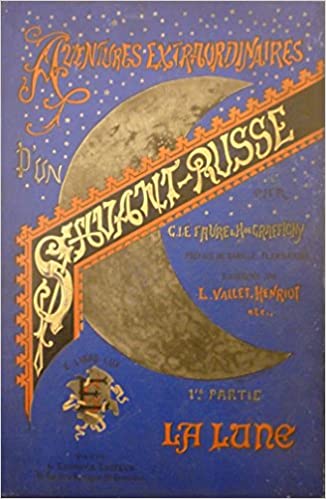
The Encyclopedia of Fantastic Victoriana
by Jess Nevins

The Extraordinary Adventures of a Russian Scientist: The Moon (1888)
copyright © Jess Nevins 2022
The Extraordinary Adventures of a Russian Scientist: The Moon (original: Aventures extraordinaires d’un savant russe: I: La lune) was written by Georges Le Faure and Henri de Graffigny. Three sequels followed in 1889 (The Sun and the Small Planets; original: Le soleil et les petites planètes), 1890 (The Giant Planets and the Comets; original: Les planètes géantes et les comètes), and 1896 (The Sidereal Desert; original: Le désert sidéral). Georges Le Faure (1858-1953) was a novelist who wrote Jules Verne-influenced science fiction and popular fiction for children. Henri de Graffigny (1863-1942) was a physicist.
Mikhail Ossipov is a Russian scientist. He guards two things with an obsessive paranoia: his daughter Selena, and selenite, an explosive which he discovered and named after his daughter. Selenite is extremely powerful; enough of it could blow up the world. But Ossipov’s arch-rival, Fyodor Sharp, trumps up charges of anarchism against Ossipov, and he is exiled to Siberia. Sharp is preparing to steal the selenite and kidnap Selena when her suitor rescues her, piloting a steam-powered airplane which he had a friend invent for him.
However, Sharp gets away with the selenite and builds a space gun, assisted by the American government, who Sharp has convinced to finance him The gun, now armed with the selenite, works, and Sharp is propelled into space. Selena and her lover take Ossipov’s spaceship, the Ossipov, to a live volcano in Siberia. The place a large cannon inside the volcano and put the Ossipov inside the cannon. The lava works as an explosive and the cannon launches the Ossipov into space. Sharp is waiting on the moon for them, and he kidnaps Selena and launches his ship for the inner planets. Ossipov and Selena’s lover pursue Sharp, first to Venus, Mercury, and Mars, and then to the outer planets. They encounter Greek-speaking Venusians and winged Martians who live in flying cities and fight wars according to regular schedules. In the end Selena is rescued, Sharp is killed, and Ossipov, Selena, and Selena’s lover return to Earth.
Although not stylistically accomplished The Extraordinary Adventures of a Russian Scientist is scientifically accurate (by the standards of the late nineteenth century) and has some interesting predictions. The series is essentially Victorian hard science fiction; the authors were familiar with contemporary rocket science and their creations are more advanced and more scientifically accurate than those of similar authors, including Jules Verne (see: The First Men in the Moon). Among the predictions in the novels are light sails, atmosphere suits, rockets, and laser communication.
The Extraordinary Adventures is, as Brian Stableford writes, “extraordinarily ambitious,”1 being a series of books that tells one continuous story. More importantly,
the historical importance of the Aventures extraordinaires d’un savant russe is primarily derived from the fact that it was a determined and highly ambitious attempt to hybridize action-adventure fiction and the popularization of science to produce a new kind of fiction: one that had much in common with the “hard science fiction” that aficionados of the American-born science fiction genre distinguished when they thought it politic to discriminate between stories that were fundamentally faithful to known science and those which merely used a lexicon of imaginary entities–spaceships, aliens, robots and so on–as standard props of futuristic costume drama or as metaphorical and symbolic devices.
...this first attempt, like all pioneering exercises, seems ham-fisted in retrospect, but the Aventures extraordinaires certainly cannot be faulted for its boldness, and even if the difficulties its authors experienced in writing it proved so taxing that neither of them ever attempted anything remotely similar again, the novel remains a monument of sorts. It is the longest scientific romance ever written, and it was not until the final years of the 20th century that the science fiction genre produced a handful of longer works. It was the first scientific romance to attempt a tour of the entire Solar System, and the first to venture outside by means of faster-than-light travel.2
Recommended Edition
Print: Georges Le Faure, H. de Graffigny, and Brian Stableford, The Extraordinary Adventures of a Russian Scientist. Encino, CA: Black Coats Press, 2011.
Online: https://catalog.hathitrust.org/Record/012391459 (in French; there is no English-language version available online).